| |
|
|
Modoc National Wildlife Refuge, just southeast of
Alturas, Modoc County, was primarily established for wintering
waterfowl. It also home to breeding Sandhill Cranes. Rita & I had
visited before in search of interesting birds. On 6 July 2007, however,
we came in search of odonates and, in particular, meadowhawks. Tim
Manolis has posted comments several years on CalOdes that this was a
good locale for meadowhawks. |
|
We arrived early, and encountered a
variety of interesting wildlife, including this Muskrat
(right). The day was bright & sunny, and odes were apparent from
the beginning of the tour route through the conclusion of it some two
hours later.
|
|
|
|

|
There were certainly meadowhawks. Some were having
sex in the middle of the road. But we put aside the Variegated
(left), and the occasional Striped, and focused on the many
yellow-bodied immature and tenerals that were bursting from marsh-edge
meadows everywhere.
|
|
|
Two species, both found in moderate
numbers, had distinctive thorax patterns: Band-winged (Western) Meadowhawk
(below left) and Black Meadowhawk (below right). Both
also had black marks atop abdominal segments 8 & 9. Western can
have an extensive wash across the base of the wings, extending out half
of the wing. Note that the lower left wing of this teneral Western
(below left) is a bit misshapen and perhaps not fully dry. At least 95%
of the meadowhawks on this date were tenerals or immature.
|
|
|
 This closer view of a Black
Meadowhawk shows the changing eye color and the thorax pattern. Rita
did see one all-black male this date; all others were like this. |
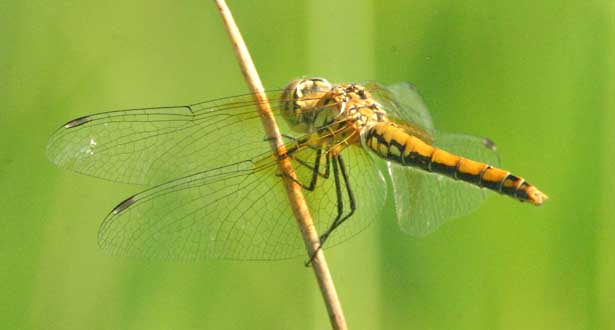 I noticed a range of variation
in the extent and obviousness of the orange wash across the inner wings
of Western Meadowhawk. This one (right) has rather little conspicuous
orange wash, but it is there when you search for it. |
|
The CalOdes archives are a wonderful resource. Four
years ago, back on 16 July 2003, Tim Manolis had written:
|
| The mountain meadows and lakes of northern
California are about ready to burst forth with the annual 'bloom' of
meadowhawks, from July through September, when it is not unusual to
find 5-6 species at a single site. Especially when a large number of
the individuals encountered at a site are tenerals, identification of
these can be very perplexing. Particularly confusing are those species
which lack strong patterning on the thorax and abdomen — Yellow-legged
[now Autumn], White-faced, Cherry-faced, and Saffron-winged. [Autumn]
emerges later than the others, has pale legs (the others have black or
mostly black legs), and is relatively rare. But the other 3 can be
confusing similar, can be quite common at some sites, and often occur
at the same sites, which is why I put them together on one plate (2)
[in my field guide]. (Manolis, Dragonflies & Damselflies of
California, 2003) |
|
|
The remainder of Tim's post explained
identification characters to use on these difficult tenerals. So it was
with that commentary, and Tim's book, that we tried to identify at
least some of the tenerals here at Modoc NWR, and other sites visited
during our northeastern California trip.
|
|
|
|
 A common meadowhawk here was Cherry-faced,
which has a plain-patterned thorax, a single black stripe down the side
of the yellowish abdomen (with little or no black atop the abdomen),
and a limited orange wash on the inner wings. This color extends out
the costal stripe only to the nodus, and then angles sharply back to
the body, forming just a little triangle of orangeish wash that does
not reach the rear edge of the any wing. A common meadowhawk here was Cherry-faced,
which has a plain-patterned thorax, a single black stripe down the side
of the yellowish abdomen (with little or no black atop the abdomen),
and a limited orange wash on the inner wings. This color extends out
the costal stripe only to the nodus, and then angles sharply back to
the body, forming just a little triangle of orangeish wash that does
not reach the rear edge of the any wing.
The pterostigma is bordered with black in front and in
the rear, and the center of the stigma ranges from brown to pale-red to
orange.
|
|
|
|
Very similar to Cherry-faced is Saffron-winged
Meadowhawk (right). The thorax and abdomen are almost
identical to my eye but the orange wash on the wings is limited to the
costal stripe and does not include a 'triangle' over the inner half of
the wing. Pterostigma color is a pale yellow, bordered fore and after
with black. The teneral to the right was a Willow Creek Wildlife Area,
Lassen Co., on 9 June 2007. We believed we saw some at Modoc NWR, but I
took no unambiguous photos there.
|
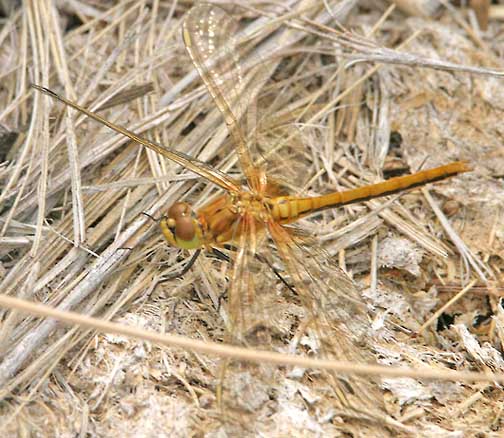 |
|
|
A final species is White-faced Meadowhawk
(right), which was rare this date at Modoc NWR so that this photo is
from Willow Lake, Plumas Co., the next day. It has a very plain thorax,
a plain abdomen with black side stripe, but very clear wings. On this
teneral the pterostigma is white.
|
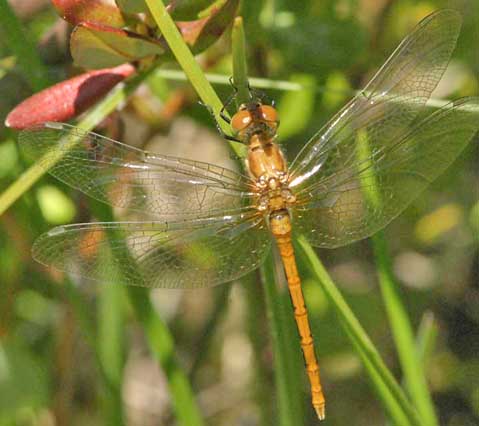 |
|
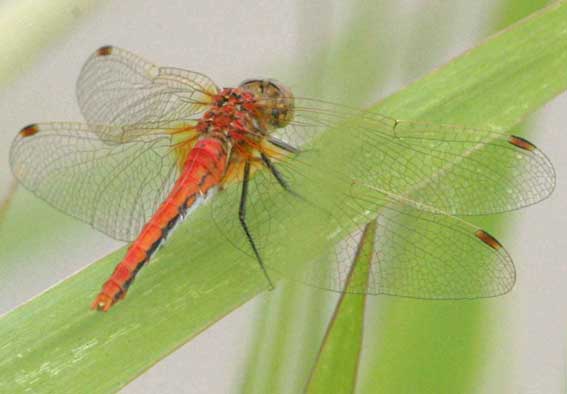 |
The only red meadowhawks that we found were along
a small ditch, and we called this one a male "Cherry-faced" as it had
the orange 'triangle' on the leading edge next to the body. Yet,
although the abdomen was nicely 'colored-up,' and had much white
pruinescence on the underside of the abdomen, the face was not yet
'cherry.'
I asked Tim Manolis & Dennis Paulson to
comment on this ode (left & below). They point out that the
appendanges are female! Old females can be red-bodied; Tim says that a
male Cherry-faced this red would have had a red face.
|
|
|
|
| The expert consensus is that is a female
Striped Meadowhawk — note the pale
spot on lower front of the thorax — but the rest of the pattern is
hidden below the red. Details of wing venation were used in analysis:
see the discussion on CalOdes. So just when we thought we were
learning these odes, we struck out on a curve ball. There is still much
too learn, which is, of course, the fun on it all. |
|
|
|
|
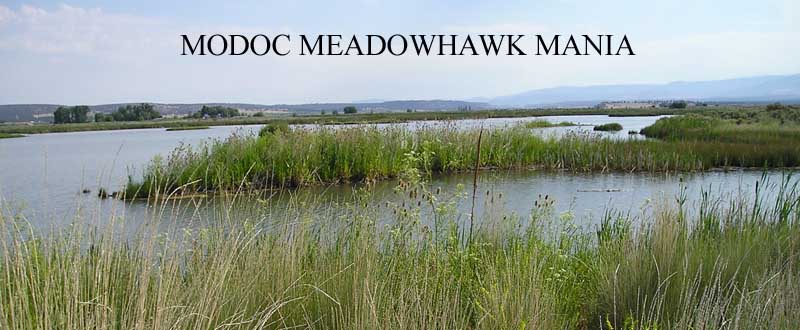
 This closer view of a Black
Meadowhawk shows the changing eye color and the thorax pattern. Rita
did see one all-black male this date; all others were like this.
This closer view of a Black
Meadowhawk shows the changing eye color and the thorax pattern. Rita
did see one all-black male this date; all others were like this.  I noticed a range of variation
in the extent and obviousness of the orange wash across the inner wings
of Western Meadowhawk. This one (right) has rather little conspicuous
orange wash, but it is there when you search for it.
I noticed a range of variation
in the extent and obviousness of the orange wash across the inner wings
of Western Meadowhawk. This one (right) has rather little conspicuous
orange wash, but it is there when you search for it. 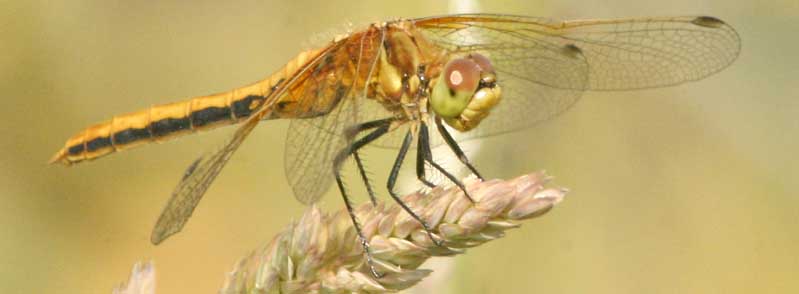
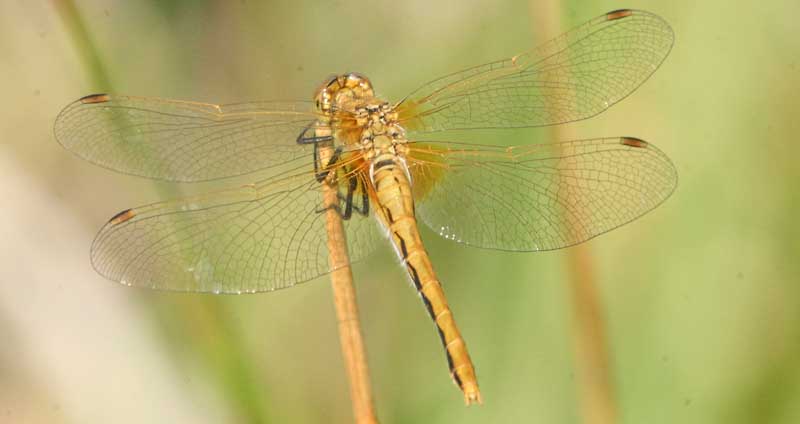
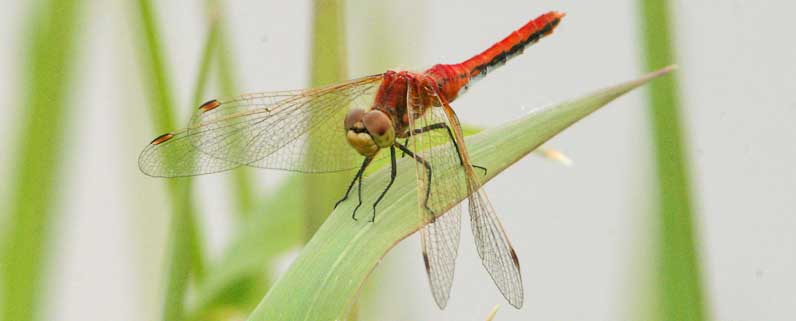
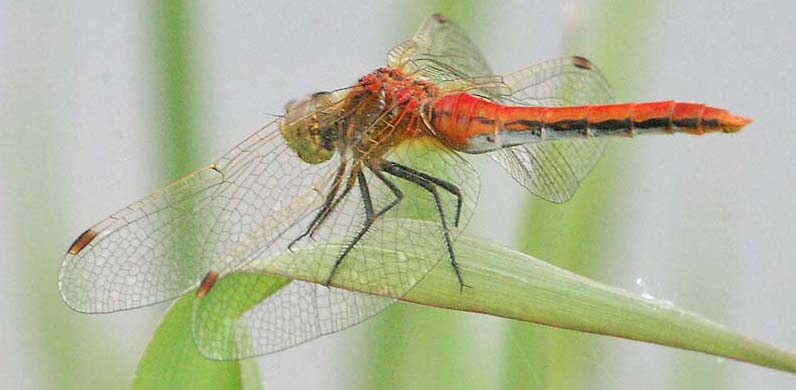

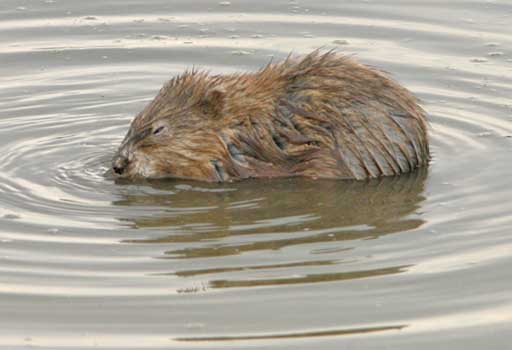

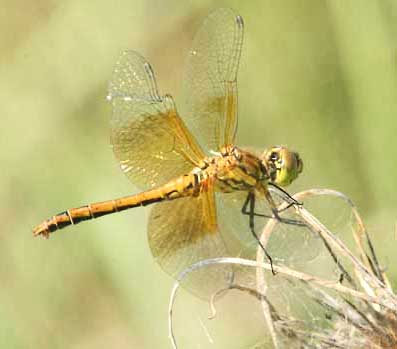
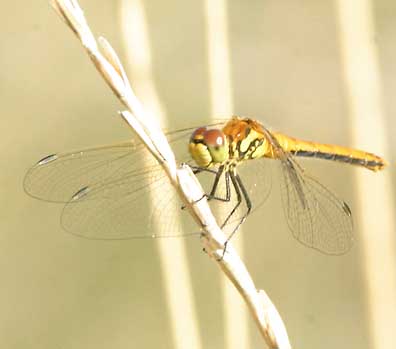
 A common meadowhawk here was Cherry-faced,
which has a plain-patterned thorax, a single black stripe down the side
of the yellowish abdomen (with little or no black atop the abdomen),
and a limited orange wash on the inner wings. This color extends out
the costal stripe only to the nodus, and then angles sharply back to
the body, forming just a little triangle of orangeish wash that does
not reach the rear edge of the any wing.
A common meadowhawk here was Cherry-faced,
which has a plain-patterned thorax, a single black stripe down the side
of the yellowish abdomen (with little or no black atop the abdomen),
and a limited orange wash on the inner wings. This color extends out
the costal stripe only to the nodus, and then angles sharply back to
the body, forming just a little triangle of orangeish wash that does
not reach the rear edge of the any wing. 

